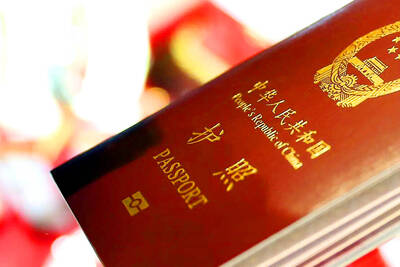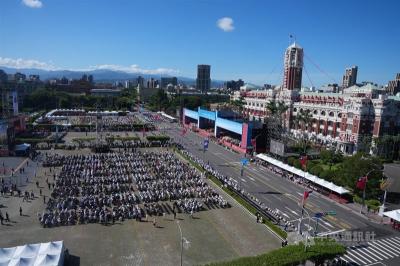Chinese Nationalist Party (KMT) presumptive presidential nominee Hung Hsiu-chu (洪秀柱) said her “one China, same interpretation” formula aims to have China recognize the existence of “the government of the Republic of China [ROC], not the existence of the ROC, otherwise it would become a ‘two-state theory.’”
Hung was interviewed on a TV talk show late on Thursday in which the host questioned her about the implications of her “one China, same interpretation” cross-strait proposal that calls for China to recognize the ROC.
“If we want China to recognize the ROC, but at the same time it is impossible for them to deny the People’s Republic of China [PRC], wouldn’t that be suggesting there are two Chinas?” the host asked.
“You have completely misunderstood [my policy],” Hung said. “It is the existence of the ROC government [that we want Beijing to recognize]. And we would also recognize the existence of the PRC government.”
“We have overlapping sovereignty claims, but are two separate governing bodies. The logic is clear and simple,” Hung said. “Taiwanese independence, if possible, would be good as well, but it is simply not possible. Changing the Constitution would incur strong opposition from both [China] and the US.”
Regarding the difficulty of obtaining the recognition of the ROC government by the PRC, which the host said had not been achieved so many years after the efforts of late Straits Exchange Foundation chairman Koo Chen-fu (辜振甫), Hung said that it should not be given up just because it is hard.
“After so many interactions and signed agreements, the fact we have still failed to achieve what we want shows there still is a lack of mutual trust between the two sides of the Taiwan Strait,” she said. “It shows that we have come to face a bottleneck in the structure built up based on the ‘1992 consensus,’ and it should be eased.”
“However, we would not say the step [of easing the bottleneck] should not be taken simply because it is difficult,” Hung said.
In response to media queries after the interview, Hung said that although the sovereignty claims of the two governments overlap, “I cannot [ask the PRC to recognize] the existence of the ROC, as that entails the [simultaneous existence] of the PRC and the ROC, which would become a ‘two-state theory.’”
Separately, during an interview with Chinese Television System aired on Thursday night and last night, President Ma Ying-jeou (馬英九) endorsed Hung’s “one China, same interpretation” formula, which he said was “almost the same as my proposal.”
The “one China, same interpretation” proposal did not go beyond “one China, different interpretations,” known as the so-called “1992 consensus,” Ma said, referring to a supposed tacit understanding between the KMT and Beijing that both sides agree there is “one China,” with each side having its own interpretation of what “China” means.
“The ‘one China, same interpretation’ proposal adheres to the ‘one China’ principle and she interprets China as the ROC, as I do,” he said.
After Hung’s “one China, same interpretation” was put forward, the US did not send its representative to meet with Hung like some other countries did, Ma said.
“That meant that [the US] is not worried about her policy,” Ma said.
Ma is expected to meet with some US officials, lawmakers and academics during transit stops in Boston and Los Angeles on his way to visit three of the nation’s allies in Central America and the Caribbean, which starts on Saturday next week.
“I will explain [Hung’s policy] to the US should they ask me about it,” Ma said.
Ma said that after he returns to Taiwan on July 18, he would attend the KMT’s national congress, which is expected to confirm Hung’s nomination.
“I don’t see any possibility that her nomination would fail to pass the national congress,” Ma said.

The Ministry of the Interior (MOI) is to tighten rules for candidates running for public office, requiring them to declare that they do not hold a Chinese household registration or passport, and that they possess no other foreign citizenship. The requirement was set out in a draft amendment to the Enforcement Rules of the Public Officials Election and Recall Act (公職人員選舉罷免法 ) released by the ministry on Thursday. Under the proposal, candidates would need to make the declaration when submitting their registration forms, which would be published in the official election bulletin. The move follows the removal of several elected officials who were

The Republic of China (ROC) is celebrating its 114th Double Ten National Day today, featuring military parades and a variety of performances and speeches in front of the Presidential Office in Taipei. The Taiwan Taiko Association opened the celebrations with a 100-drummer performance, including young percussionists. As per tradition, an air force Mirage 2000 fighter jet flew over the Presidential Office as a part of the performance. The Honor Guards of the ROC and its marching band also heralded in a military parade. Students from Taichung's Shin Min High School then followed with a colorful performance using floral imagery to represent Taiwan's alternate name

FOUR DESIGNATED AREAS: Notices were issued for live-fire exercises in waters south and northwest of Penghu, northeast of Keelung and west of Kaohsiung, they said The military is planning three major annual exercises across the army, navy and air force this month, with the navy’s “Hai Chiang” (海強, “Sea Strong”) drills running from today through Thursday, the Ministry of National Defense said yesterday. The Hai Chiang exercise, which is to take place in waters surrounding Taiwan, would feature P-3C Orion maritime patrol aircraft and S-70C anti-submarine helicopters, the ministry said, adding that the drills aim to bolster the nation’s offshore defensive capabilities. China has intensified military and psychological pressure against Taiwan, repeatedly sending warplanes and vessels into areas near the nation’s air defense identification zone and across

COVETED PRIZE: The US president would be a peace prize laureate should he persuade Xi Jinping to abandon military aggression against Taiwan, William Lai said US President Donald Trump should get the Nobel Peace Prize should he be able to convince Chinese President Xi Jinping (習近平) to abandon the use of force against Taiwan, President William Lai (賴清德) told a conservative US radio show and podcast in an interview. The US is Taiwan’s most important international backer, despite the absence of formal ties, but since Trump took office earlier this year he has not announced any new arms sales to the nation. Trump could meet Xi at the APEC summit in South Korea on Oct. 31 and Nov. 1. Lai, speaking on The Clay Travis and Buck Sexton